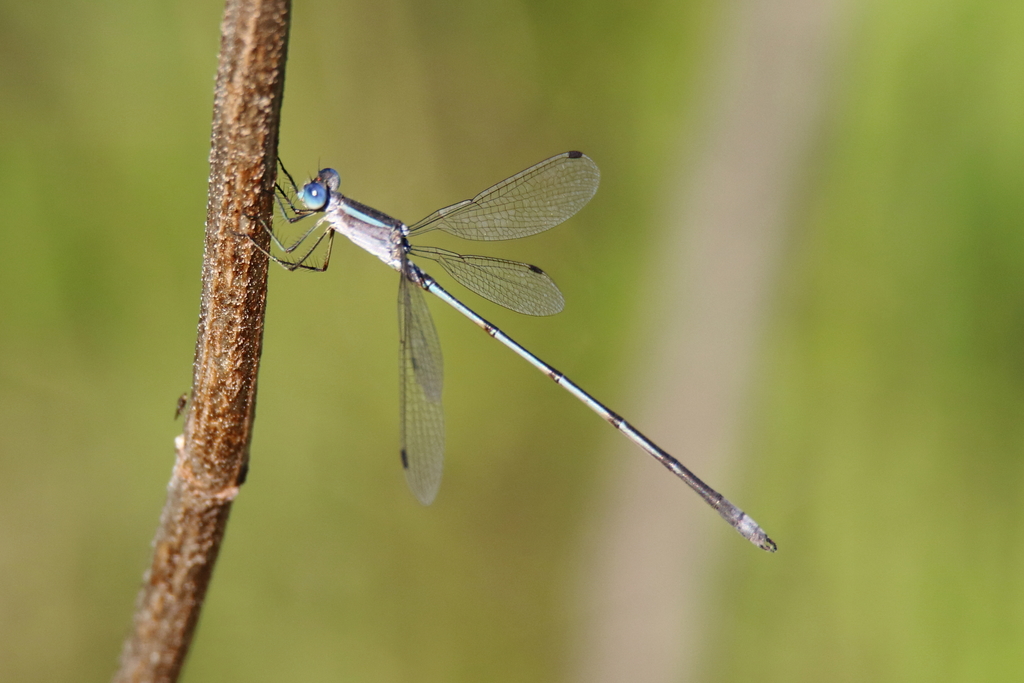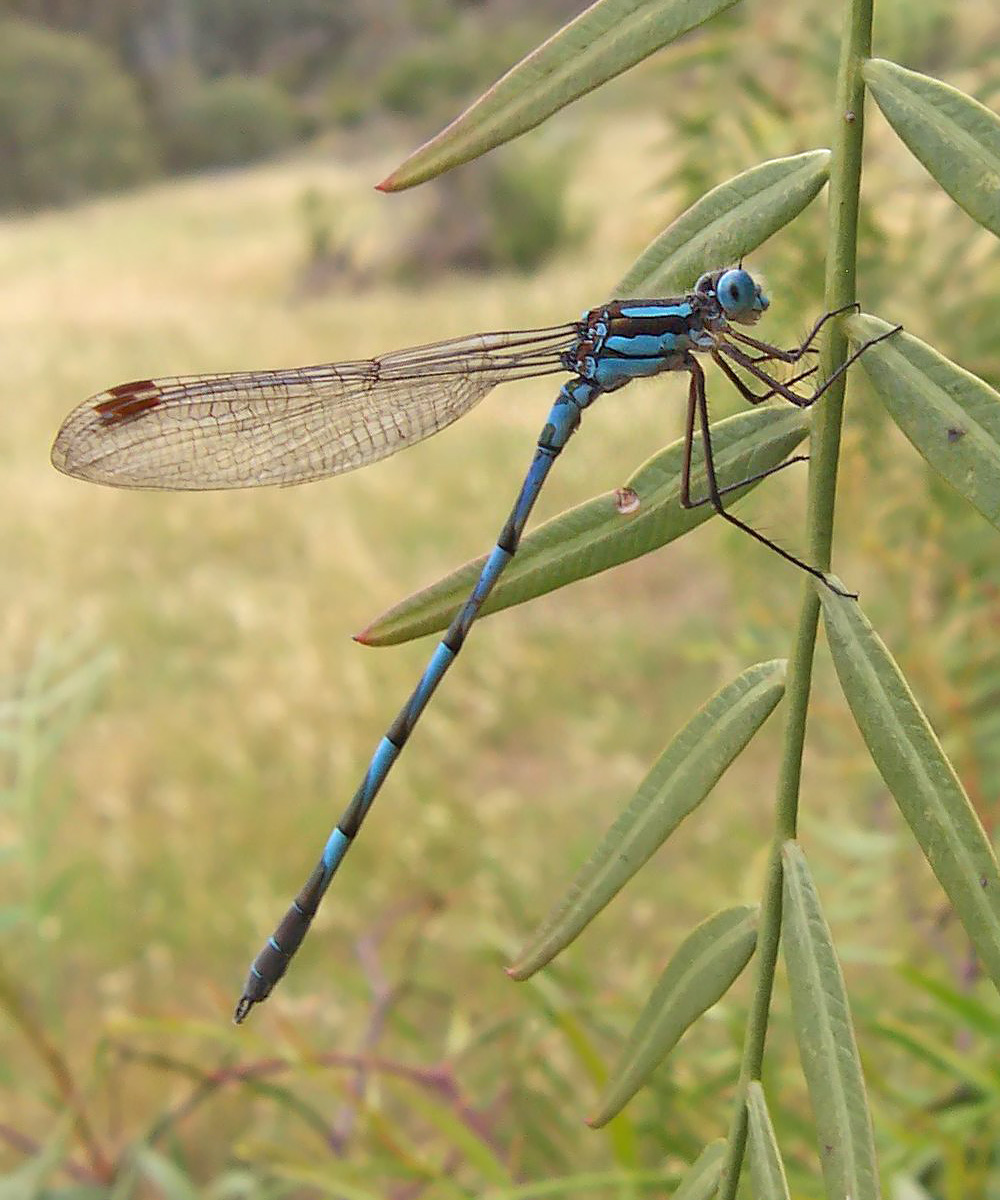|
Elegant Spreadwing
The elegant spreadwing (''Lestes inaequalis'') is a species of damselfly in the family Lestidae, the spreadwings. It is native to eastern North America, including eastern Canada and the United States.NatureServe. 2015''Lestes inaequalis''.NatureServe Explorer. Version 7.1. Accessed January 28, 2016. Description This species is 45 to 60 millimeters long.''Lestes inaequalis''. Odonata Central. The male has a metallic green and yellow thorax and a blue-tipped green abdomen. The body is pruinose Pruinescence , or pruinosity, is a "frosted" or dusty-looking coating on top of a surface. It may also be called a pruina (plural: ''pruinae''), from the Latin word for hoarfros ...
[...More Info...] [...Related Items...] OR: [Wikipedia] [Google] [Baidu] [Amazon] |
Damselfly
Damselflies are flying insects of the suborder Zygoptera in the order Odonata. They are similar to dragonflies (which constitute the other odonatan suborder, Epiprocta) but are usually smaller and have slimmer bodies. Most species fold the wings along the body when at rest, unlike dragonflies which hold the wings flat and away from the body. Damselflies have existed since the Late Jurassic, and are found on every continent except Antarctica. All damselflies are predatory insects: both nymphs and adults actively hunt and eat other insects. The nymphs are aquatic, with different species living in a variety of freshwater habitats including acidic bogs, ponds, lakes and rivers. The nymphs moult repeatedly, at the last moult climbing out of the water to undergo metamorphosis. The skin splits down the back, they emerge and inflate their wings and abdomen to gain their adult form. Their presence on a body of water indicates that it is relatively unpolluted, but their dependence on fr ... [...More Info...] [...Related Items...] OR: [Wikipedia] [Google] [Baidu] [Amazon] |
Family (biology)
Family (, : ) is one of the eight major hierarchical taxonomic ranks in Linnaean taxonomy. It is classified between order and genus. A family may be divided into subfamilies, which are intermediate ranks between the ranks of family and genus. The official family names are Latin in origin; however, popular names are often used: for example, walnut trees and hickory trees belong to the family Juglandaceae, but that family is commonly referred to as the "walnut family". The delineation of what constitutes a family—or whether a described family should be acknowledged—is established and decided upon by active taxonomists. There are not strict regulations for outlining or acknowledging a family, yet in the realm of plants, these classifications often rely on both the vegetative and reproductive characteristics of plant species. Taxonomists frequently hold varying perspectives on these descriptions, leading to a lack of widespread consensus within the scientific community ... [...More Info...] [...Related Items...] OR: [Wikipedia] [Google] [Baidu] [Amazon] |
Lestidae
The Lestidae are a rather small family of cosmopolitan, large-sized, slender Damselfly, damselflies, known commonly as the spreadwings or spread-winged damselflies. Characteristics While most Zygoptera, damselflies rest with their wings folded together, most members of the family Lestidae hold them at an angle away from their bodies. The pterostigma (a single dark spot in the meshwork of the leading edge near the tip of each wing) is noticeably elongated. The quadrilateral (a part of the wing venation, close to the body) has an acute angle at the end. The body has a greenish, metallic shine. The superior anal appendages, commonly called claspers (body parts of male insect for clasping the female during copulation) of male spreadwings are long and strongly curved. Breeding takes place in slow-moving or still water in stream backwaters, swamps, marshes and temporary pools. The nymphs have a long abdomen and a distinctive prementum (part of the lower lip). There is one generation ... [...More Info...] [...Related Items...] OR: [Wikipedia] [Google] [Baidu] [Amazon] |
Pruinescence
Pruinescence , or pruinosity, is a "frosted" or dusty-looking coating on top of a surface. It may also be called a pruina (plural: ''pruinae''), from the Latin word for hoarfrost. The adjectival form is pruinose . Entomology In insects, a "bloom" caused by wax particles on top of an insect's cuticle covers up the underlying coloration, giving a dusty or frosted appearance. The pruinescence is commonly white to pale blue in color but can be gray, pink, purple, or red; these colors may be produced by Tyndall scattering of light. When pale in color, pruinescence often strongly reflects ultraviolet. Pruinescence is found in many species of Odonata, particularly damselflies of the families Lestidae and Coenagrionidae, where it occurs on the wings and body. Among true dragonflies it is most common on male Libellulidae (skimmers). In the common whitetail and blue dasher dragonflies (''Plathemis lydia'' and ''Pachydiplax longipennis''), males display the pruinescence on the back of the ... [...More Info...] [...Related Items...] OR: [Wikipedia] [Google] [Baidu] [Amazon] |
Lestes Vigilax
''Lestes vigilax'', the swamp spreadwing, is a damselfly of the genus ''Lestes''. It grows between 42 and 55 mm long. It ranges from eastern North America west to Minnesota, Oklahoma, and Texas, and to Georgia and South Carolina South Carolina ( ) is a U.S. state, state in the Southeastern United States, Southeastern region of the United States. It borders North Carolina to the north and northeast, the Atlantic Ocean to the southeast, and Georgia (U.S. state), Georg .... It is most commonly seen between May and October. References * vigilax Odonata of North America Insects of the United States Fauna of the Eastern United States Insects described in 1862 {{Lestoidea-stub ... [...More Info...] [...Related Items...] OR: [Wikipedia] [Google] [Baidu] [Amazon] |
Lestes Eurinus
''Lestes'' is a genus of damselfly in the family Lestidae. The family hold their wings at about 45 degrees to the body when resting. This distinguishes them from most other species of damselflies which hold the wings along, and parallel to, the body when at rest. The name ''Lestes'' comes from the Greek Greek may refer to: Anything of, from, or related to Greece, a country in Southern Europe: *Greeks, an ethnic group *Greek language, a branch of the Indo-European language family **Proto-Greek language, the assumed last common ancestor of all kno ... word λῃστής (lēistēs) meaning ''predator''. Extant Species The genus ''Lestes'' includes the following species: Fossils *'' Lestes aquisextana '' *'' Lestes arvernus '' *'' Lestes brisaci '' *'' Lestes ceresti '' *'' Lestes conexus '' *'' Lestes datangensis '' *'' Lestes dianacompteae '' *'' Lestes forsterii '' *'' Lestes irenea '' *'' Lestes leucosia '' *'' Lestes ligea '' *'' Lestes lutzi '' *'' Lestes peisinoe '' * ... [...More Info...] [...Related Items...] OR: [Wikipedia] [Google] [Baidu] [Amazon] |
Lestes
''Lestes'' is a genus of damselfly in the family Lestidae. The family hold their wings at about 45 degrees to the body when resting. This distinguishes them from most other species of damselflies which hold the wings along, and parallel to, the body when at rest. The name ''Lestes'' comes from the Greek language, Greek word λῃστής (lēistēs) meaning ''predator''. Extant Species The genus ''Lestes'' includes the following species: Fossils *''Lestes aquisextana '' *''Lestes arvernus '' *''Lestes brisaci '' *''Lestes ceresti '' *''Lestes conexus '' *''Lestes datangensis '' *''Lestes dianacompteae '' *''Lestes forsterii '' *''Lestes irenea '' *''Lestes leucosia '' *''Lestes ligea '' *''Lestes lutzi '' *''Lestes peisinoe '' *''Lestes plicata '' *''Lestes regina '' *''Lestes sieblosiformis '' *''Lestes statzi '' *''Lestes vicina '' *''Lestes zalesskyi'' See also *Chalcolestes References External links * * {{Taxonbar , from=Q2649380 Lestes, Lestidae Zygoptera gen ... [...More Info...] [...Related Items...] OR: [Wikipedia] [Google] [Baidu] [Amazon] |
Odonata Of North America
Odonata is an order of predatory flying insects that includes the dragonflies and damselflies (as well as the '' Epiophlebia'' damsel-dragonflies). The two major groups are distinguished with dragonflies (Anisoptera) usually being bulkier with large compound eyes together and wings spread up or out at rest, while damselflies (suborder Zygoptera) are usually more slender with eyes placed apart and wings folded together along body at rest. Adult odonates can land and perch, but rarely walk. All odonates have aquatic larvae called naiads or nymphs, and all of them, larvae and adults, are carnivorous and are almost entirely insectivorous, although at the larval stage they will eat anything that they can overpower, including small fish, tadpoles, and even adult newts. The adults are superb aerial hunters and their legs are specialised for catching prey in flight. Odonata in its narrow sense forms a subgroup of the broader Odonatoptera, which contains other dragonfly-like insects. T ... [...More Info...] [...Related Items...] OR: [Wikipedia] [Google] [Baidu] [Amazon] |
Insects Of Canada
Insects (from Latin ') are Hexapoda, hexapod invertebrates of the class (biology), class Insecta. They are the largest group within the arthropod phylum. Insects have a chitinous exoskeleton, a three-part body (Insect morphology#Head, head, Thorax (insect anatomy), thorax and abdomen (insect anatomy), abdomen), three pairs of jointed Arthropod leg, legs, compound eyes, and a pair of antenna (biology), antennae. Insects are the most diverse group of animals, with more than a million described species; they represent more than half of all animal species. The insect nervous system consists of a insect brain, brain and a ventral nerve cord. Most insects reproduce Oviparous, by laying eggs. Insects Respiratory system of insects, breathe air through a system of Spiracle (arthropods), paired openings along their sides, connected to Trachea#Invertebrates, small tubes that take air directly to the tissues. The blood therefore does not carry oxygen; it is only partly contained in ves ... [...More Info...] [...Related Items...] OR: [Wikipedia] [Google] [Baidu] [Amazon] |
Fauna Of The Eastern United States
The fauna of the United States of America is all the animals living in the contiguous United States and its surrounding seas and islands, the Hawaiian Archipelago, Alaska in the Arctic, and several Territories of the United States, island-territories in the Pacific and in the Caribbean. The U.S. has many endemic species found nowhere else on Earth. With most of the North American continent, the U.S. lies in the Nearctic, Neotropic, and Oceanian realm, Oceanic faunistic realms, and shares a great deal of its flora and fauna with the rest of the Americas, American supercontinent. An estimated 432 mammal species comprise the fauna of the continental U.S. There are more than 800 species of bird and more than 100,000 known species of insect. There are 311 known reptiles, 295 amphibians and 1154 known fish species in the U.S. Known animals that exist in all of the Contiguous United States, lower 48 states include white-tailed deer, bobcat, raccoon, muskrat, striped skunk, American ba ... [...More Info...] [...Related Items...] OR: [Wikipedia] [Google] [Baidu] [Amazon] |





